Hilversum | |
|---|---|
City and municipality | |
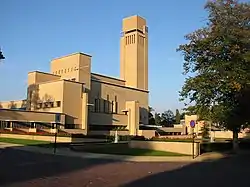 | |
 Flag  Coat of arms | |
.svg.png.webp) Location in North Holland | |
| Coordinates: 52°14′N 5°10′E / 52.233°N 5.167°E | |
| Country | Netherlands |
| Province | North Holland |
| Region | Amsterdam metropolitan area |
| Town Hall | Hilversum Town Hall |
| Government | |
| • Body | Municipal council |
| • Mayor | Gerhard van den Top (Non-partisan) |
| • Aldermen | List of aldermen
|
| Area | |
| • Total | 46.35 km2 (17.90 sq mi) |
| • Land | 45.61 km2 (17.61 sq mi) |
| • Water | 0.74 km2 (0.29 sq mi) |
| Elevation | 15 m (49 ft) |
| Population (January 2021)[4] | |
| • Total | 90,261 |
| • Density | 2,000/km2 (5,000/sq mi) |
| Demonym(s) | Hilversummer (male), Hilversumse (female) |
| Time zone | UTC+1 (CET) |
| • Summer (DST) | UTC+2 (CEST) |
| Postcode | 1200–1223 |
| Area code | 035 |
| Website | www |
Hilversum (Dutch pronunciation: [ˈɦɪlvərsʏm] ⓘ) is a city and municipality in the province of North Holland, Netherlands. Located in the heart of the Gooi, it is the largest urban centre in that area. It is surrounded by heathland, woods, meadows, lakes and smaller towns. Hilversum is part of the Randstad, one of the largest conurbations in Europe, and the Amsterdam metropolitan area; it is about 22 km southeast of Amsterdam's city centre and about 15 km north of Utrecht.
The city is home to the headquarters, studios and broadcast stations of several major radio, television and newspaper companies such as Nederlandse Omroep Stichting. Hilversum is thus known for being the mediastad (media city) of the Netherlands.
Town
Hilversum lies 24 km (15 mi) south-east of Amsterdam and 15 km (9.3 mi) north of Utrecht. The town is known for its architecturally important Town Hall (Raadhuis Hilversum), designed by Willem Marinus Dudok and built in 1931.
Hilversum has one public library, two swimming pools (Van Hellemond Sport and De Lieberg), a number of sporting halls, and several shopping centers (such as Hilvertshof, Winkelcentrum Kerkelanden, De Riebeeckgalerij, and Winkelcentrum Seinhorst). Locally, the town center is known as het dorp, which means "the village".
Geography
Hilversum is located on the sandy, hilly parts of the Gooi, and has four hills: the closest to the centre of town in the Boomberg. Then the Trompenberg (now a luxury residential area where including the Brenninkmeijer family lives, of C&A-fame), and to the south the Hoorneboeg (25 m) and two kilometres easterly of that the Zwaluwenberg, where since 1950 the headquarters of the inspector-general of the armies is located. These hills date from the period of the Ice-age, when gletschers pushed walls of earth before them. Hilversum was the farthest southern edge the glaciers reached.
Surrounding towns are Nieuw-Loosdrecht, Bussum, Kortenhoef, Blaricum, Hollandsche Rading, Lage Vuursche, Maartensdijk, 's-Graveland, Laren, Nederhorst den Berg and Ankeveen.
Hilversum consists of the following districts and neighborhoods: Center (Langgewenstbuurt, Sint Vitusbuurt, Havenstraatbuurt and Centrum), Northwest (Nimrodpark, Trompenberg North, Trompenberg South, Media Park, Raadhuiskwartier and Boomberg), Northeast (North, Johannes Geradtswegbuurt, Erfgooiersbuurt and AZC Crailo), East (Geuzenbuurt, Electrobuurt, Astronomiebuurt, Science neighborhood, Kamrad, Kleine Driftbuurt and Liebergen), Southeast (Bloemkwartier Noord, Bloemenkwartier Zuid, Painterskwartier, 't Hoogt van' t Kruis, Arenaparkkwartier and West Indiëkwartier), Zuid (Writerskwartier, Staatsliedenkwartier and Zeeheldenkwartier), Southwest ( Kerkelanden, Havenkwartier, Zeverijn and Het Rode Dorp) and Hilversumse Meent. In 1767 Hilversum was still divided into 4 districts (quarters): the Neuquartier, Groestquartier, Kerkquartier and the Sandtbergerquartier.
The Oude Haven in the southwest is at the end of the Gooische Vaart. The construction of the canal between 's-Graveland and Hilversum was done in stages, so that it took 240 years. The canal was completed in 1876. Later, a modern harbor was dug, surrounded by an industrial estate. There is also a sports harbor.
International
Hilversum has a variety of international schools, such as the Violenschool and International School Hilversum "Alberdingk Thijm". Also, Nike's,[5] Hunkemöller's[6] and Converse's[7] European headquarters are located in Hilversum.
History
Earthenware found in Hilversum gives its name to the Hilversum culture, which is an early- to mid-Bronze Age, or 1800–1200 BC material culture. Artifacts from this prehistoric civilization bear similarities to the Wessex Culture of southern Britain and may indicate that the first Hilversum residents emigrated from that area.[8]
The first brick settlements formed around 900, but it was not until 1305 that the first official mention of Hilversum ("Hilfersheem" from "Hilvertshem" meaning "houses between the hills") is found. At that point it was a part of Naarden, the oldest town in the Gooi area.

Farming, raising sheep and some wool manufacturing were the means of life for the Gooi in the Middle Ages. In 1424 Hilversum received its first official independent status. This made possible further growth in the village because permission from Naarden was no longer needed for new industrial development.
The town grew further in the 17th century when the Dutch economy as a whole entered its age of prosperity, and several canals were built connecting it indirectly to Amsterdam.
In 1725 and 1766 large fires destroyed most of the town, leveling parts of the old townhouse and the church next to it. The town overcame these setbacks and the textile industry continued to develop, among other ways by devising a way to weave cows' hair.
In the 19th century a substantial textile and tapestry industry emerged, aided by a railway link to Amsterdam in 1874. From that time the town grew quickly with rich commuters from Amsterdam moving in, building themselves large villas in the wooded surroundings, and gradually starting to live in Hilversum permanently. Despite this growth, Hilversum was never granted city rights so it is still referred to by many locals as "het dorp", or "the village."
For the 1928 Summer Olympics in neighboring Amsterdam, it hosted all of the non-jumping equestrian and the running part of the modern pentathlon event.[9]
The Nederlandse Seintoestellen Fabriek (NSF) company established a professional transmitter and radio factory in Hilversum in the early 1920s, growing into the largest of its kind in the Netherlands.
Following the defeat of Allied forces in the Netherlands in 1940, and its occupation by Nazi Germany, Hilversum became the headquarters of the German Army (Heer) in the Netherlands. On February 25 and 26, 1941, most of Hilversum's factories went on strike against the start of the Holocaust in the so-called February strike (Amsterdam Docker's Strike). Some 10,000 people took part. There is a yearly remembrance service since 2015. The Holocaust was the reason for 2,000 Hilversum Jews to lose their lives. The community has never recovered fully. Some 50 Hilversummers were awarded the title of Righteous among the nations from Yad Vashem. Victor Kugler, one of Anne Frank's helper, was one of them.
In 1948, NSF was taken over by Philips. However, Dutch radio broadcasting organizations (followed by television broadcasters during the 1950s) centralised their operations in Hilversum, providing a source of continuing economic growth. The concentration of broadcasters in Hilversum has given it its enduring status as the media city for the Netherlands.
In 1964, the population reached a record high – over 103,000 people called Hilversum home. However, the textile industry had started its decline; only one factory, Veneta, managed to continue into the 1960s, when it also had to close its doors. Another major industry, the chemical factory IFF, also closed by the end of the 1960s.
After the 1960s, the population gradually declined, until stabilising at around 85,000. Several factors other than the slump in manufacturing have featured in this decline: one is the fact that the average family nowadays consists of fewer people, so fewer people live in each house; second, the town is virtually unable to expand because all the surrounding lands were sold by city architect W.M. Dudok to the Goois Natuurreservaat (nl). The third reason for this decline of the population was because the property values were increasing rapidly in that moment of time, and many people were forced to move to less expensive areas in the Netherlands.
Some sources blame connections in the television world for attracting crime to Hilversum; the town has had to cope with mounting drug-related issues in a community with higher than average unemployment and ongoing housing shortage.
Hilversum was one of the first towns to have a local party of the populist movement called Leefbaar ("liveable"). Founded by former social-democrat party strongman Jan Nagel, it was initially held at bay for alderman positions. In 2001, Nagel from Leefbaar Hilversum teamed up with Leefbaar Utrecht leaders to found a national Leefbaar Nederland party. By strange coincidence, in 2002 the most vocal Leefbaar Rotterdam politician Pim Fortuyn was shot and killed by an animal rights activist at Hilversum Media Park just after finishing a radio interview. This happened, however, after a break between Fortuyn and Nagel during a Leefbaar Nederland board meeting in Hilversum on Fortuyn's anti-Islamic viewpoints.
The town of Hilversum has put a great deal of effort into improvements, including a recent renovation to its central train station, thorough renovation of the main shopping centre (Hilvertshof), and development of new dining and retail districts downtown including the "vintage" district in the Leeuwenstraat. Several notable architectural accomplishments include the Institute for Sound and Vision,[10] and Zanderij Crailoo (nl), the largest man-made wildlife crossing in the world.
The nearby Media Park was the scene of the 2002 assassination of politician Pim Fortuyn; in 2015, a gunman carrying a false pistol stormed into Nederlandse Omroep Stichting's headquarters, demanding airtime on the evening news.
The population declined from 103,000 in 1964 to 84,000 in 2006, but rose again to 90.000 in 2018. The decline is mostly due to the fact that families are smaller these days.
Culture

There is the large Catholic neo-gothic St. Vitus church (P.J.H. Cuypers, 1892, bell tower 96 metres; 315'). The city played host to many landscape artists during the 19th century, including Barend Cornelis Koekkoek.
In the 1950s and 1960s the city played host to a major European Tennis tournament.
The 1958 Eurovision Song Contest took place in Hilversum. In 2020 the international television event Eurovision: Europe Shine a Light was broadcast from Studio 21 in Hilversum's Media Park. This event was held in place of the Eurovision Song Contest 2020 which was cancelled due to the COVID-19 pandemic.
Broadcasting
Hilversum is often called "media city", since it is the principal centre for radio and television broadcasting in the Netherlands, and is home to an extensive complex of radio and television studios and to the administrative headquarters of the multiple broadcasting organizations which make up the Netherlands Public Broadcasting system. Hilversum is also home to many newer commercial TV production companies. Radio Netherlands, which had been broadcasting worldwide via shortwave radio since the 1920s, was also based in Hilversum until it was dissolved in 2013.
The following is a list of organizations that have, or are continuing to, broadcast from studios in Hilversum:
- NCRV (1924–2013)
- KRO (1925–2013)
- VARA (1925–2013)
- VPRO (1926–present)
- AVRO (1927–2013)
- RVU (1930–2010)
- IKOR (1946–1975)
- NRU (1947–1969)
- RNW (1947–2012)
- NTS (1951–1969)
- IKON (1976–2015)
- NOT (1962–1996)
- Teleac (1963–2010)
- TROS (1964–2013)
- EO (1967–present)
- NOS (1969–present)
- VOO (1976–1995)
- Human (1989–present)
- NPS (1995–2010)
- BNN (1997–2013)
- MAX (2005–present)
- PowNed (2009–present)
- WNL (2009–present)
- NTR (2010–present)
- AVROTROS (2014–present)
- BNNVARA (2014–present)
- KRO-NCRV (2014–present)
One result of the town's history as an important radio transmission centre is that many older radio sets throughout Europe featured Hilversum as a pre-marked dial position on their tuning scales.
Dutch national voting in the Eurovision Song Contest is normally co-ordinated from Hilversum.
Transport
Airport
Hilversum Airport is located in the southwest of the municipality. Next to it is the former Marine Training Camp (MOK), now Corporal Van Oudheusden Barracks for the medical troops. In wartime the airfield was expanded significantly by the German military. They also set up an assembly line for training aircraft, produced by Fokker in Weesp.
Railway
Hilversum is well connected to the Dutch railway network, and has three stations.
| Station | Notes |
|---|---|
| Hilversum | Opened on 10 June 1874. Served by regional, Intercity and international trains. |
| Hilversum Media Park | Opened on 26 May 1974. Previously named Hilversum NOS (1974-1989) and Hilversum Noord (1989-2013). Only served by regional trains. |
| Hilversum Sportpark | Opened on 1 June 1886. Previously named Amersfoortsche Straatweg (1886-1919) and Soestdijker Straatweg (1919-1965). Only served by regional trains. |
Public buses
Most local and regional buses are operated by Connexxion, but two of the bus routes are operated by Syntus Utrecht and two others by U-OV and Pouw Vervoer. Regional bus route 320 is operated by both Connexxion and Pouw Vervoer. In 2018, major road works started to make room for a new BRT bus lane from Hilversum to Huizen, set to open in early 2021.[11][12]
Local bus lines
| Line | Route | Operator | Notes |
|---|---|---|---|
| 1 | Hilversum Station - Centrum (Downtown) - Kerkelanden | Connexxion | |
| 2 | Hilversum Station - Over 't Spoor - Erfgooiers | Connexxion | |
| 3 | Hilversum Station - Hilversum Sportpark Station - Tergooi Ziekenhuis (Hospital) | Connexxion |
Regional bus lines
| Line | Route | Operator | Notes |
|---|---|---|---|
| 58 | Hilversum Station - Hollandsche Rading - Maartensdijk - Bilthoven - De Bilt - Zeist | U-OV and Pouw Vervoer | Mon-Sat during daytime hours only. U-OV operates this route during weekdays, Pouw Vervoer on Saturdays. |
| 59 | Hilversum Station - Lage Vuursche - Den Dolder - Huis ter Heide - Zeist | U-OV and Pouw Vervoer | Mon-Sat during daytime hours only. U-OV operates this route during weekdays, Pouw Vervoer on Saturdays. |
| 70 | Amersfoort Station - Soest Zuid - Soest Overhees - Soestdijk Noord - Hooge Vuursche - Hilversum Station | Syntus Utrecht; a few runs are operated by Pouw Vervoer and Van Kooten | |
| 100 | (Hilversum Station -) Blaricum Bijvanck - Huizen - Naarden-Bussum Station | Connexxion | The route between Hilversum and Blaricum is only served during weekday daytime hours. |
| 104 | Hilversum Station - Hilversum-Zuid - Nieuw-Loosdrecht | Connexxion | |
| 105 | Hilversum Station - Kortenhoef - 's-Graveland - Hilversumse Meent - Naarden-Bussum Station | Connexxion | |
| 106 | (Hilversum Station - Kortenhoef -) Nederhorst den Berg - Weesp Station | Connexxion | Mon-Sat only. Only runs through from Nederhorst den Berg to Hilversum Mon-Fri during daytime hours. |
| 107 | Hilversum Station - Hilversum Mediapark - Bussum - Blaricum Ziekenhuis (Hospital) | Connexxion | |
| 108 | Hilversum Station - Laren - Blaricum Dorp - Huizen | Connexxion | |
| 109 | Hilversum Station - Eemnes - Laren - Blaricum Ziekenhuis (Hospital) - Naarden-Bussum Station | Connexxion | |
| 121 | Hilversum Station - Oud-Loosdrecht - Loenen aan de Vecht - Vinkeveen - Wilnis - Mijdrecht | Syntus Utrecht | Mon-Sat during daytime hours only. Only runs between Hilversum and Vinkeveen, Groenlandsekade on Saturdays. |
| 320 | Hilversum Station - Hilversum Arenapark - Blaricum Bijvanck - Huizen - Blaricum Ziekenhuis (Hospital) - Naarden Gooimeer - Muiden P+R - Amsterdam Amstel Station | Connexxion and Pouw Vervoer | During weekday daytime hours, Saturday mornings and Sunday evenings, some buses only run between Hilversum and Huizen. During morning rush hours, 4 extra buses run between Hilversum Station and Hilversum Arenapark. |
| N32 | Hilversum Station → Eemnes → Blaricum Bijvanck → Huizen | Pouw Vervoer | Only runs during Saturday late nights (between midnight and 5 AM). |
Local government
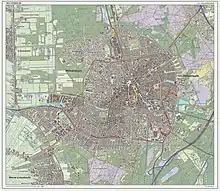
The municipal council of Hilversum consists of 37 seats, which are divided as follows since the last local election of 2018:[13]
- Hart voor Hilversum - 8 seats
- D66 – 7 seats
- VVD – 6 seats
- GroenLinks – 5 seats
- CDA – 4 seats
- SP – 2 seats
- PvdA – 2 seats
- ChristenUnie – 2 seats
- Leefbaar Hilversum – 1 seat
Government
After the 2018 elections, the municipal government was made up of aldermen from the political parties Hart voor Hilversum, D66 and VVD.
The mayor of Hilversum is Gerhard van den Top.
It was the first city with a "Leefbaar" party (which was intended as just a local party). Today, Leefbaar Hilversum has been reduced to only 1 seat, but some other parties have their origins in Leefbaar Hilversum:
- Hart voor Hilversum. Originated from a Leefbaar Hilversum separation party called DLPH, which won 1 seat in the 2006 elections. Leadership was taken over in 2006 by Leonie Sazias, a TV celebrity. Leonie Sazias later changed the party name to Hart voor Hilversum. She won 3 seats in the 2010 elections and increased her influence to 6 seats in 2014. They won the 2018 elections and have 8 seats now.
- Hilversum 1. Was founded by Hans Roos, originally a council member for Hart voor Hilversum, but due to disagreements with the party on the list of candidates for the elections in 2014, decided to split and start his own party in 2013.[14]
Notable residents
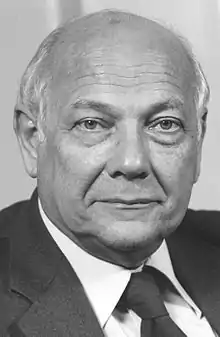

.jpg.webp)
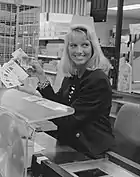
Notable people born in Hilversum:
Public service & public thinking
- H. A. Sinclair de Rochemont (1901–1942) a Dutch fascist and later a Nazi collaborator
- Jan van den Brink (1915–2006) a Dutch politician and businessman
- Joop den Uyl (1919–1987) Prime Minister of the Netherlands 1973 to 1977
- Wilhelmus Luijpen (1922–1980) a Dutch philosopher, Catholic priest of the Order of St. Augustine and an existential phenomenologist
- Ineke van Wetering (1934-2011) a Dutch anthropologist who studied witchcraft in Suriname
- Hubert van Es (1941-2009), war journalist in Vietnam
- John Gerretsen (born 1942), politician in Ontario, Canada
- Ernst Bakker (1946–2014) a Dutch politician, Mayor of Hilversum 1998 to 2011
- Olga Fischer (born 1951) a Dutch linguist and academic
- Bartha Knoppers (born 1951), a Canadian lawyer
- André Rouvoet (born 1962), a retired Dutch politician
- Janneke Raaijmakers (born 1973) a Dutch historian of the Middle Ages, focus on the Fulda monastery
The arts
- Jan Teulings (1905–1989) a Dutch actor[15]
- Emmy Lopes Dias (1919–2005) a Dutch stage, radio, and TV actress and advocate for the right to die[16]
- Pim Jacobs (1934–1996) a Dutch jazz pianist, composer and TV presenter
- Chris Hinze (born 1938) a Dutch former pianist, now jazz and New Age flautist
- Harry van Hoof (born 1943) a Dutch conductor, composer and music arranger
- Harmke Pijpers (born 1946) a Dutch journalist and radio and TV presenter[17]
- Dick Diamonde (born 1947) a retired Dutch Australian bass guitar player
- Ton Scherpenzeel (born 1952), keyboardist and founder of the Dutch rock band Kayak
- Pim Koopman (1953–2009), drummer of the Dutch progressive rock band, Kayak
- Max Werner (born 1953), former lead singer and drummer of the rock band Kayak
- Erland Van Lidth de Jeude (1953–1987), a Dutch-American actor, opera singer and amateur wrestler[18]
- Arjan Ederveen (born 1956) a Dutch actor, comedian, TV scriptwriter and TV director[19]
- Luc Leestemaker (1957–2012) an American abstract expressionist artist
- Arjen Anthony Lucassen (born 1960), a Dutch singer, songwriter, musician and record producer
- Bert Boeren (born 1962) a Dutch jazz trombonist and educator
- Ruud de Wild (born 1969) a Dutch radio host[20]
- Dave Luza (born 1974), an improvisational comedian
- Liza Ferschtman (born 1979) a Dutch classical violinist
- Marieke Blaauw (born 1979) a Dutch animator[21]
- Nicolette Kluijver (born 1984) a Dutch TV presenter and former model[22]
- Rami Ismail (born 1988) a Dutch-Egyptian video games developer
- Lucas & Arthur Jussen, Lucas (born 1993) and Arthur (born 1996) are brothers and form a piano duo.
- Sick Individuals (founded 2010) a Dutch electronic dance music act
- Christina Mahler, Canadian chellist
Science & business
- J. W. B. Gunning (1860–1913), Dutch physician and museum director in South Africa
- Joop van Oosterom (1937–2016), Dutch billionaire and chess and billiards sponsor
- Bessel Kok (born 1941), Dutch businessman and chess organiser
- Wim van den Brink (born 1952), Professor of Psychiatry and Addiction at the University of Amsterdam
- Henkjan Honing (born 1959), Professor of Music Cognition at the University of Amsterdam
- John de Mol (born 1955), media tycoon and TV producer
- Pieter Geelen (born 1964), Dutch entrepreneur, co-developed the Mapcode
- Olaf Swantee (born 1966), Dutch businessman, former CEO of EE Limited
Sport
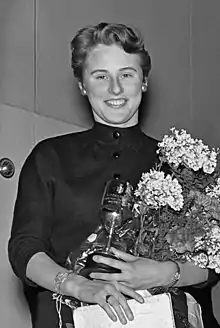
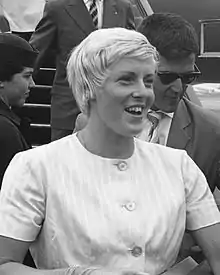
- de Looper brothers, Henk (1912–2006) and Jan (1914–1987) Dutch field hockey players and bronze medallists at the 1936 Summer Olympics
- Nel van Vliet (1926–2006) a breaststroke swimmer, gold medallist at the 1948 Summer Olympics
- Roel Wiersma (1932–1995) a Dutch footballer, 316 club caps with PSV Eindhoven
- Geertje Wielema (1934–2009) a freestyle and backstroke swimmer, silver medallist at the 1952 Summer Olympics
- Hermsen brothers, Henk (born 1937), André (born 1942) and Wim (born 1947), water polo players
- Mary Kok (born 1940) a renowned Dutch swimmer
- Adrie Lasterie (1943–1991) a Dutch swimmer, silver medallist at the 1964 Summer Olympics
- Evert Kroon (born 1946), water polo goalkeeper, bronze medallist at the 1976 Summer Olympics
- nl:John van Altena (born 1947) 107 caps, Dutch National Rugby XV
- Ton van Klooster (born 1954), freestyle swimmer and swimming coach, competed at the 1972 Summer Olympics
- Nico Landeweerd (born 1954), water polo player, bronze medallist at the 1976 Summer Olympics
- Andy Hoepelman (born 1955), water polo player, bronze medallist at the 1976 Summer Olympics
- Albert Voorn (born 1956) a Dutch equestrian and silver medallist at the 2000 Summer Olympics
- Alex Boegschoten (born 1956) a former water polo player, bronze medallist at the 1976 Summer Olympics
- Hansje Bunschoten (born 1958–2017), swimmer and TV presenter, competed at the 1972 Summer Olympics
- Ellen Bontje (born 1958), equestrian, team medallist at the 1992 and 2000 Summer Olympics
- Reggie de Jong (born 1964), freestyle swimmer, bronze medallist at the 1980 Summer Olympics
- Jelle Goes (born 1970) a Dutch football manager
- Pieta van Dishoeck (born 1972) a retired rower, won two medals at the 2000 Summer Olympics
- Davy Klaassen (born 1993) a Dutch professional footballer with 180 club caps
Gallery
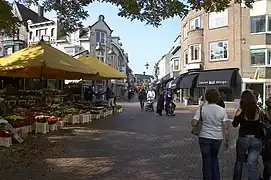 Hilversum city centre
Hilversum city centre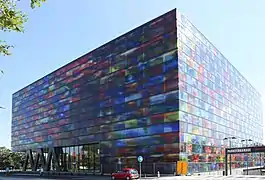 Sound and Vision (Nederlands Instituut voor Beeld en Geluid)
Sound and Vision (Nederlands Instituut voor Beeld en Geluid)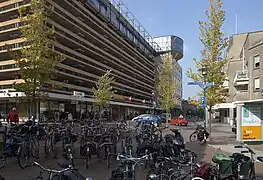 Shopping district Noordse Bosje
Shopping district Noordse Bosje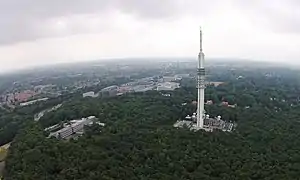 Media Park, Hilversum
Media Park, Hilversum 2020-08-19 Drone Shot Raadhuis and Media Park, Hilversum
2020-08-19 Drone Shot Raadhuis and Media Park, Hilversum
See also
References
- ↑ "College van Burgemeester en Wethouders" [Board of mayor and aldermen] (in Dutch). Gemeente Hilversum. Archived from the original on 21 April 2016. Retrieved 1 August 2014.
- ↑ "Kerncijfers wijken en buurten 2020" [Key figures for neighbourhoods 2020]. StatLine (in Dutch). CBS. 24 July 2020. Retrieved 19 September 2020.
- ↑ "AHN Postcode tool for 1217JE". Actueel Hoogtebestand Nederland (in Dutch). Het Waterschapshuis. Retrieved 1 August 2014.
- ↑ "Bevolkingsontwikkeling; regio per maand" [Population growth; regions per month]. CBS Statline (in Dutch). CBS. 1 January 2021. Retrieved 2 January 2022.
- ↑ "Nike European Headquarters". jobs.nike.com.
- ↑ Talk:Hilversum#cite note-2
- ↑ "Locations". jobs.converse.com.
- ↑ "Hilversum: Overview - History". Iguide.travel. Retrieved 5 May 2012.
- ↑ 1928 Summer Olympics official report. pp. 271–8.
- ↑ "Beeld en Geluid" (in Dutch). Experience.beeldengeluid.nl. Archived from the original on 18 November 2009.
- ↑ "HOV in 't Gooi - Provincie Noord-Holland". www.noord-holland.nl (in Dutch).
- ↑ "Aanleg snelle busbaan HOV Gooi opnieuw vertraagd". www.nhnieuws.nl (in Dutch).
- ↑ Hilversum. "Gemeenteraadsleden en fractiemedewerkers - Hilversum". www.hilversum.nl (in Dutch). Retrieved 4 November 2016.
- ↑ regio, dichtbij.nl – nieuws en informatie uit de (16 December 2013). "Hans Roos door als Hilversum 1". dichtbij.nl. Retrieved 4 November 2016.
- ↑ IMDb Database retrieved 4 December 2019
- ↑ IMDb Database retrieved 4 December 2019
- ↑ IMDb Database retrieved 4 December 2019
- ↑ IMDb Database retrieved 2 December 2019
- ↑ IMDb Database retrieved 3 December 2019
- ↑ IMDb Database retrieved 4 December 2019
- ↑ IMDb Database retrieved 3 December 2019
- ↑ IMDb Database retrieved 4 December 2019
External links
 Media related to Hilversum at Wikimedia Commons
Media related to Hilversum at Wikimedia Commons- Official website


